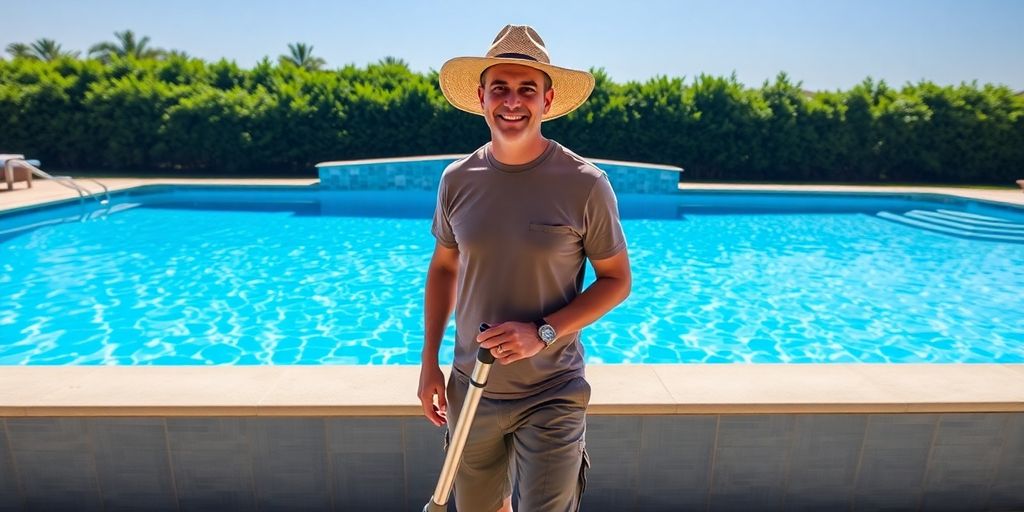G’day, fellow pool owners! If you’re keen to keep your backyard oasis sparkling clean without too much fuss, you’ve come to the right place. We’re gonna chat about how to clean your pool with a vacuum, just like a true blue Aussie. It’s not as hard as you might think, and once you get the hang of it, you’ll be wondering why you didn’t start sooner. Let’s get stuck in and make that pool shine!
Key Takeaways
- Regularly clean pool with vacuum to keep it sparkling.
- Pick the right vacuum head for your pool type.
- Prep your pool properly before you start vacuuming.
- Use slow, steady strokes for the best clean.
- Always look after your gear after each use.
Why Clean Your Pool With A Vacuum?

Let’s be honest, nobody wants to swim in a pool that looks like a swamp after a big storm. While your pool’s filtration system does a decent job, it can’t always handle everything. That’s where a good old pool vacuum comes in handy. It’s not just about getting rid of the big stuff; it’s about keeping your water sparkling clean and your pool in top nick.
Simple And Efficient Cleaning
Using a pool vacuum, especially a manual one, gives you direct control over the cleaning process. You can target those tricky spots where leaves and gunk tend to gather, like corners or steps, that an automatic cleaner might miss. It’s a straightforward way to get your pool looking schmick without too much fuss. You just hook it up, and off you go, sucking up all the bits and pieces that have settled on the bottom. It’s a bit like using a regular vacuum cleaner in your house, but for your pool. Plus, you don’t have to worry about complicated programming or sensors playing up.
Built To Last For Aussie Conditions
Our Aussie weather can be pretty harsh, right? Blazing sun, sudden downpours, and all sorts of debris blowing into the pool. That’s why you need gear that can handle it. Good quality pool vacuums are made from tough materials that won’t crack or fade under the sun’s glare. They’re designed to withstand the chemicals in your pool water too, so they won’t fall apart after a few uses. This means you’re investing in something that will last you for ages, saving you money in the long run. You want something that’s as tough as a bull, ready for anything our climate throws at it.
Improved Water Quality For A Sparkling Pool
Getting rid of all that debris from the bottom of your pool does more than just make it look good. It actually helps keep your water chemistry balanced. When leaves and dirt break down in the water, they can mess with your pH levels and use up your chlorine, making your pool cloudy or even green. By vacuuming regularly, you’re taking out those contaminants before they can cause problems. This means less work for your philtre, less need for extra chemicals, and ultimately, clearer, healthier water that’s a joy to swim in. It’s all about keeping things clean from the ground up.
Here’s how regular vacuuming helps your pool:
- Reduces organic load: Less leaves and debris means less stuff breaking down in your water.
- Maintains chemical balance: Fewer contaminants mean your chlorine works more effectively.
- Extends philtre life: Your philtre doesn’t have to work as hard to remove large particles.
- Prevents algae growth: By removing food sources for algae, you make it harder for them to take hold.
- Enhances clarity: A clean bottom means a truly sparkling pool.
While robotic pool cleaners are great for daily maintenance, a manual vacuum is still your best mate for a proper deep clean, especially after a big storm or if the pool’s been neglected for a bit. It’s about having the right tool for the job, and sometimes, that’s a good old manual vacuum.
Choosing The Right Pool Vacuum Head
Alright, cobber, picking the right vacuum head is a bit like choosing the right ute for the job – you want something that’s gonna get stuck in and do the work properly. It’s not just about grabbing the first one you see; you gotta think about your pool’s surface and what kind of gunk you’re usually dealing with. A good vacuum head makes all the difference for a sparkling clean pool.
True Blue Vinyl Liner Pool Vacuum Head
If you’ve got a vinyl-lined pool, or even an above-ground one, this is your go-to. These heads are designed to be gentle on those delicate surfaces, so you won’t scratch or tear anything while you’re getting rid of the muck. They often come with soft brushes that are tough on dirt but kind to your liner.
- Lightweight design to prevent damage
- Soft, non-abrasive brushes
- Often weighted to stay on the pool floor
Aussie Gold Flexible Pool Vacuum Head
Now, for concrete or fibreglass pools, a flexible head is usually the way to go. These beauties can bend and flex, letting you get into all those tricky corners and curves without missing a spot. They’re built a bit tougher too, ready to handle the rough and tumble of a solid pool surface.
Don’t fall for those all-in-one vacuum heads with brushes built right in. While they sound good on paper, in reality, the brushes often push debris around instead of letting the vacuum suck it up. You’re better off with a dedicated vacuum head and a separate brush for scrubbing.
Compatibility With Your Existing Gear
Before you splash your cash, make sure the new vacuum head will actually fit your existing setup. Most are pretty standard, but it’s always worth a double-check. You’ll want to make sure it connects properly to your telescopic pole and your pool hose.
- Check hose size (32mm or 38mm are common)
- Ensure it fits your telescopic pole
- Look for universal attachments if you’re unsure
Getting Started: Pre-Vacuuming Prep
Righto, before you even think about dunking that vacuum head in, there’s a bit of groundwork to do. Think of it like prepping the barbie before throwing on the snags – a bit of effort now saves a whole lot of grief later. Getting your ducks in a row before you start vacuuming is key to a smooth, effective clean.
Gather Your Cleaning Kit
First things first, round up all your gear. You don’t want to be halfway through and realise you’ve left your pole on the other side of the yard. Here’s what you’ll need:
- Your trusty pool vacuum head (the one you picked out earlier, remember?)
- A telescopic pole, long enough to reach every nook and cranny
- Your pool hose – make sure it’s free of kinks and holes
- A skimmer box vacuum plate (if you’re using one)
- A pool brush, for those stubborn bits
It’s a bit like getting ready for a road trip; you wouldn’t just jump in the car without checking the fuel and tyres, would ya? Same goes for pool cleaning. A quick check of your kit means no mid-job dramas.
Check Your Pool’s Water Level
This one’s a ripper. Before you start, have a squiz at your pool’s water level. It needs to be at the right height for your skimmer to work properly and for your pump to get a good prime. If it’s too low, you risk sucking air into your system, which is a real pain in the backside and can damage your pump. If it’s a bit low, top it up with the garden hose. Easy as that.
Brush Down The Pool Walls
Alright, this is where you get a bit of a workout. Grab your pool brush and give the walls and floor a good scrub. This knocks any loose dirt and algae off the surfaces and into the water column, making it easier for your vacuum to suck it all up. Think of it as loosening the dirt before you sweep the floor inside. Pay extra attention to those shady spots where algae loves to hang out. For those really stubborn bits, a dustpan and brush might be needed if the pool is empty.
Mastering The Pool Vacuuming Technique

Alright, cobber, once you’ve got your gear sorted and the pool’s ready, it’s time to get stuck into the actual vacuuming. It’s not just about pushing the vacuum head around; there’s a bit of a knack to it if you want a truly sparkling result.
Slow And Steady Wins The Race
This isn’t a sprint, mate, it’s a marathon. Moving your pool vacuum head slowly and deliberately is the secret to picking up all that gunk without stirring it up. If you go too fast, you’ll just kick up the dirt and debris, turning your crystal-clear water into a cloudy mess. Then you’ll have to wait for it all to settle again, which is a right pain. Think of it like mowing the lawn – nice, even passes, no rushing.
You want to give the vacuum head time to suck up everything in its path. Patience is a virtue when you’re trying to get your pool looking its best. Don’t be tempted to speed things up, or you’ll just create more work for yourself in the long run.
Overlap Your Strokes For A Thorough Clean
Just like painting a wall or mowing the lawn, you need to overlap your strokes to make sure you don’t miss any spots. Start at one end of the pool, usually the shallow end, and work your way across. Each pass should slightly overlap the previous one. This systematic approach ensures you cover every inch of the pool floor.
- Begin at the shallow end, working towards the deep end.
- Use long, straight strokes, moving the vacuum head in a consistent direction.
- Overlap each stroke by about a quarter to a third of the vacuum head’s width.
- Pay extra attention to corners and areas where debris tends to settle.
Dealing With Stubborn Debris
Sometimes you’ll come across a patch of stubborn gunk that just won’t budge on the first go. Don’t stress, it happens. For these tricky bits, you might need to go over them a couple of times. If it’s really stuck, you can try a slightly firmer, but still slow, push. For saltwater pool maintenance, regular vacuuming helps prevent buildup.
Here’s a quick guide for tackling different types of debris:
| Debris Type | Recommended Action |
|---|---|
| Fine Silt | Very slow, gentle passes; may require multiple attempts. |
| Leaves | Go over slowly; if large, consider using a leaf skimmer first. |
| Algae Spots | Brush first to loosen, then vacuum slowly. |
Post-Vacuuming Pool Care
Alright, you’ve done the hard yards, the pool’s looking spick and span after a good vacuum. But the job’s not quite done yet, mate! There are a few crucial steps to take after you’ve finished vacuuming to make sure your pool stays sparkling and your gear stays in top nick. Think of it as the cool-down lap after a big race – just as important as the race itself.
Backwash Your Philtre Like A Pro
After all that vacuuming, especially if your pool was a bit of a shocker, your philtre’s probably copped a fair bit of gunk. Backwashing your philtre is super important to get rid of all that trapped debris and keep your filtration system running smoothly. If you’ve got a sand philtre, you’ll know the drill: turn off the pump, set the valve to ‘backwash’, turn the pump back on until the water in the sight glass runs clear, then turn off the pump again. Don’t forget to rinse! If you vacuumed to waste, you’ll definitely need to top up your water level afterwards. For cartridge philtres, it’s more about giving them a good hose down. Keeping your philtre clean means your pool water stays clearer for longer, and your pump doesn’t have to work overtime.
Check Your Pool’s Water Chemistry
Vacuuming, especially if you’ve had to add fresh water, can throw your pool’s chemistry out of whack. It’s like adding a new ingredient to a recipe – you need to rebalance everything. Grab your test kit and check the usual suspects:
- Chlorine levels: Make sure they’re in the ideal range to keep those nasties at bay.
- pH balance: Too high or too low can cause all sorts of dramas, from cloudy water to irritated eyes.
- Alkalinity: This helps buffer your pH, keeping it stable.
Don’t skip this step! A balanced pool is a happy pool, and it’ll save you a heap of headaches down the track. Getting your water chemistry right after a good clean means you’re setting yourself up for success, preventing algae blooms and other issues that can pop up if things are out of whack. It’s all about maintaining that perfect swimming environment.
Address Any Cloudiness Promptly
Sometimes, even after a thorough vacuum, your pool might look a bit cloudy. Don’t stress, it happens! This usually means your philtre needs a bit more attention, or there’s some fine particulate matter still floating around. Here’s what you can do:
- Run your philtre longer: Give it a good 24-hour run to catch any lingering particles.
- Check your philtre again: If you haven’t already, give your philtre another clean or backwash. A dirty philtre is the number one culprit for cloudy water.
- Consider a clarifier: A good quality pool clarifier can help those tiny particles clump together, making it easier for your philtre to pick them up. Just follow the instructions on the bottle.
By taking these steps, you’ll ensure your pool stays crystal clear and inviting, ready for your next dip. A little bit of post-vacuuming care goes a long way in maintaining a pristine swimming hole. For more tips on keeping your pool in top shape, check out this pool cleaning guide.
Benefits Of A Quality Pool Vacuum Head
Choosing the right pool vacuum head isn’t just about getting the job done; it’s about making your life easier and keeping your pool sparkling without a fuss. A good quality vacuum head is a real game-changer for any pool owner, especially here in Australia where our pools get a fair bit of use. It’s not just a piece of gear; it’s an investment in hassle-free pool maintenance. You want something that’s going to stand up to the harsh sun and keep performing, season after season. A top-notch vacuum head means less time wrestling with debris and more time enjoying your backyard oasis.
Effortless Debris Removal
Let’s be honest, nobody wants to spend their weekend scrubbing the bottom of the pool. A quality vacuum head makes short work of all that gunk – leaves, dirt, sand, even those pesky little bugs that seem to find their way in. It’s designed to pick up everything efficiently, so you’re not going over the same spot a dozen times. The weighted design of many good heads means they stay put on the pool floor, giving you consistent suction and a thorough clean every time. It’s all about getting that debris out of your pool and into your philtre, where it belongs.
When you’ve got a vacuum head that actually works, you’ll notice a massive difference in how quickly and easily you can clean your pool. It’s not just about speed; it’s about getting a proper clean without breaking your back. This means less effort for you and a cleaner pool for everyone to enjoy.
Durable Materials For Longevity
Our Aussie climate is no joke, especially on pool gear. That’s why the materials a vacuum head is made from are super important. You want something that’s built tough, able to handle the relentless UV rays and the chemicals in your pool water without falling apart after a few months. Look for vacuum heads made from things like UV-stabilised and chemical-resistant PVC or robust rubberised plastic. These materials ensure your vacuum head will last for ages, saving you from having to replace it every other year. It’s about getting value for your hard-earned cash.
- UV-stabilised plastic resists sun damage.
- Chemical-resistant materials prevent corrosion from pool chemicals.
- Heavy-duty construction stands up to regular use.
Versatile For All Pool Types
One of the best things about a quality pool vacuum head is its versatility. Whether you’ve got a concrete pool, a fibreglass one, or a vinyl liner, there’s a vacuum head out there that’ll work a treat. Many are designed to glide smoothly over different surfaces without causing any damage. Plus, most good ones are compatible with standard telescopic poles and common hose sizes (like 32mm and 38mm), so you can easily hook them up to your existing gear. This means you don’t need a whole new setup just to get a good clean. It’s all about making pool maintenance as straightforward as possible, no matter what kind of pool you’ve got. For comprehensive pool maintenance, consider a pool maintenance routine that includes regular vacuuming.
Maintaining Your Pool Vacuum Gear
Look, you’ve invested in some fair dinkum gear to keep your pool sparkling, right? So, it only makes sense to look after it properly. A bit of TLC goes a long way in making sure your pool vacuum head and all its bits and bobs last for ages, saving you a few quid in the long run and keeping your pool looking mint. It’s not rocket science, just a few simple habits.
Rinse After Each Use
After you’ve finished your vacuuming session, don’t just chuck your gear back in the shed. Give your vacuum head, hose, and pole a good rinse with fresh water. This washes off any pool chemicals, dirt, and tiny bits of gunk that might be clinging on. If you leave that stuff on, it can corrode the materials over time, especially the metal bits, and make everything brittle. Think of it like giving your ute a quick wash after a trip to the beach – gets rid of the salt and sand, keeps it looking good.
Store In A Shady Spot
The Aussie sun is a beauty, but it’s a killer on plastic and rubber. Leaving your pool vacuum gear out in direct sunlight is a surefire way to shorten its lifespan. The UV rays will make the plastic brittle and faded, and the rubber seals and hoses will crack and perish. Find a nice, cool, shady spot to store everything. A shed, a garage, or even under a covered patio is ideal. Just make sure it’s out of the elements.
Keeping your pool cleaning equipment in tip-top shape isn’t just about making it last longer; it’s about making your next cleaning job easier and more effective. A well-maintained vacuum head glides smoothly and picks up debris like a champion, while neglected gear can turn a simple chore into a frustrating battle.
Regularly Inspect For Wear And Tear
It’s a good idea to give your pool vacuum gear a quick once-over every now and then, even if you’re rinsing it after each use. Look for any signs of wear and tear. Are there any cracks in the plastic? Is the hose getting stiff or showing signs of splitting? Are the brushes on your vacuum head worn down? Catching these issues early means you can replace a small part before it turns into a bigger problem. For instance, if you’ve got a robotic pool cleaner, you’d be checking its tracks and brushes regularly. It’s like checking the tyres on your car – a bit of preventative maintenance can save you a lot of hassle down the track.
Here’s a quick checklist for your regular inspection:
- Vacuum Head: Check the brushes for wear, look for cracks in the body, and ensure the wheels (if it has them) spin freely.
- Hose: Inspect for kinks, cracks, or holes. Make sure the cuffs are still flexible and seal properly.
- Telescopic Pole: Check that the locking mechanisms work smoothly and that the pole extends and retracts without sticking.
- Connections: Ensure all connections (like where the hose attaches to the vacuum head) are secure and not leaking.
Wrapping it Up
So there you have it, folks! Getting your pool sparkling clean with a vacuum isn’t some big mystery. It’s just about knowing a few simple steps and having the right gear. You don’t need to be a pool expert to get it done. Just take your time, follow these tips, and you’ll have a pool that’s ready for a swim, no worries. It’s all about keeping things simple and getting the job done right, so you can spend more time enjoying your backyard oasis and less time scrubbing. Happy swimming!
Frequently Asked Questions
Why should I bother vacuuming my pool?
Using a pool vacuum is a ripper way to keep your pool sparkling clean. It’s super simple, works a treat for getting rid of all sorts of gunk, and helps keep your water healthy so you don’t need as many chemicals. Plus, our vacuum heads are built tough for the Aussie climate, so they’ll last ages.
What kind of pool vacuum head should I get?
You’ve got a couple of top choices! The ‘True Blue’ vinyl liner vacuum head is spot-on for vinyl pools, but it’s also good for concrete and fibreglass. It’s got brushes to scrub away dirt. Then there’s the ‘Aussie Gold’ flexible vacuum head, which is ace for all pool types, from concrete to tiled. Both are built tough and connect easily to your standard pool gear.
What should I do before I start vacuuming?
Before you dive in, make sure you’ve got all your bits and bobs ready, like your pole and hose. Give your pool’s water level a quick check – you want it just right. And a quick brush of the pool walls before you start vacuuming helps loosen up any stubborn bits, making your job heaps easier.
What’s the best way to vacuum my pool?
Take it easy, mate! Don’t rush it. Move the vacuum head slowly and smoothly across the pool floor. Make sure you overlap your strokes a bit, like you’re mowing the lawn, so you don’t miss any spots. If you hit a really dirty patch, just go over it a few times.
What do I do after I’ve finished vacuuming?
Once you’re done, give your philtre a good backwash to get rid of all the crud you’ve sucked up. Then, it’s a good idea to check your pool’s water chemistry to make sure everything’s balanced. If your water looks a bit cloudy, don’t stress – it usually means your philtre needs a clean, so sort that out quick smart.
How do I look after my pool vacuum equipment?
To keep your gear in top nick, always give your vacuum head and hose a good rinse with fresh water after each use. Store them somewhere shady, out of the harsh Aussie sun, to stop them from getting damaged. And every now and then, have a squiz to check for any wear and tear so you can fix it before it becomes a big problem.





